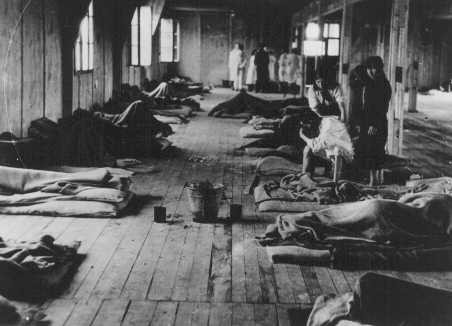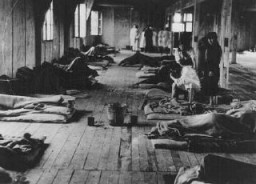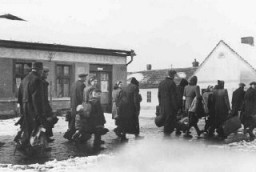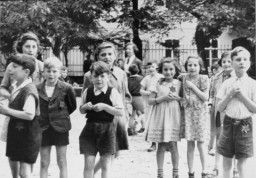
Theresienstadt: Key Dates
Key dates in the history of the Theresienstadt "camp-ghetto," which existed for three and a half years, between November 24, 1941, and May 9, 1945. During its existence, Theresienstadt served multiple purposes.
October 1–10, 1938
Nazi Germany occupies and annexes the Sudetenland in accordance with the provisions of the Munich Agreement of September 29, 1938. The Sudetenland consisted of the border regions of the Czechoslovak provinces of Bohemia and Moravia directly adjacent to the territory of the Greater German Reich. The Bohemian city Leitmeritz (Litomerice), on the new border between the Greater German Reich and the Czecho-Slovak state, lay within the Sudeten lands.
March 15, 1939
Nazi Germany occupies the remainder of the Czech provinces and establishes the Protectorate of Bohemia and Moravia as part of the Greater German Reich. The Czech garrison town of Theresienstadt (Terezin), less than a mile southeast of Litomerice, is located within the Protectorate near the extended German border.
October 10, 1941
RSHA chief Reinhard Heydrich expresses his preference for Theresienstadt as the site for a Jewish “settlement” for those German, Austrian, and Czech Jews who were
- over 65 years of age
- disabled or highly decorated World War I veterans
- of sufficient regional, national or international celebrity to encourage domestic and foreign inquiry
Heydrich tasks the Gestapo office IV B 4 under Adolf Eichmann and the Prague Office for Jewish Emigration under Hans Günther with the establishment and management of the Theresienstadt camp-ghetto.
October 17, 1941
The SS and police send the first transport of Czech Jews to the East, from Prague to the Lodz ghetto.
October 30, 1941
Heydrich appoints SS First Lieutenant Siegfried Seidl as commandant of the camp-ghetto.
November 16, 1941
The SS and police deport the sixth transport of Czech Jews to the East, from Brno to Minsk, Belorussia. 5,997 or 5,998 persons are on the six transports.
November 24, 1941
The first Jewish construction detachment arrives in Theresienstadt.
November 24, 1941–April 15, 1945
The SS and police deport between 73,608 and 75,958 Czech Jews residing in the Protectorate of Bohemia and Moravia to Theresienstadt.
December 4, 1941
Eichmann appoints Prague Zionist leader Jacob Edelstein chairperson of the Council of Jewish Elders, responsible for the “self-administration” of Theresienstadt. Edelstein arrives in Theresienstadt.
January 9, 1942
SS authorities send the first transport of Protectorate Jews, carrying 1,005 people, from Theresienstadt to the East, specifically to Riga, Latvia.
January 9, 1942–October 22, 1942
The SS and police deport approximately 42,005 people, most of them Jews residing in the Protectorate, from Theresienstadt to killing sites, killing centers, concentration camps, and forced-labor camps in the Baltic States, Belorussia, and the Generalgouvernement. 224 are known to have survived the Holocaust (one half of one per cent of those deported).
January 20, 1942
RSHA chief Heydrich announces the existence and propaganda purpose of Theresienstadt to officials of the SS, the Nazi Party, and the German state gathered to discuss the implementation of “Final Solution” policy—the annihilation of the European Jews—at the Wannsee Conference at a villa just outside Berlin.
June 2, 1942
The first transport of German Jews—50 Jews from Berlin—arrives at Theresienstadt.
June 20, 1942
The first transport of Austrian Jews—between 996 and 1,000 Jews from Vienna—arrives at Theresienstadt.
June 2, 1942–April 15, 1945
SS and police authorities deport approximately 58,087 Jews from the Greater German Reich (excluding Protectorate Jews) to Theresienstadt (from Germany: 41,783; Austria: 15,266; Sudetenland: 611; German-annexed Luxembourg: 310; and Danzig: 117).
July 14, 1942
The SS and police send the first transport containing some German Jews from Theresienstadt to the East, specifically to Minsk.
October 26, 1942–October 28, 1944
German SS and Police deport approximately 46,750 Jews from Theresienstadt to Auschwitz-Birkenau in 27 transports. Approximately 23,670 had been residents of the so-called Greater German Reich and 18,500 residents of the Protectorate of Bohemia and Moravia. Perhaps 3,450 survive.
January 1943
Eichmann appoints Paul Eppstein from Berlin and Benjamin Murmelstein from Vienna as co-chairpersons with Edelstein of the Council of Jewish Elders in Theresienstadt.
1943–1944
4,897 Jews arrive in Theresienstadt from the Netherlands via Westerbork or Bergen-Belsen. Those transported include a minority of German Jews who had emigrated to the Netherlands in the 1930s, and three French Jews.
August 24, 1943
1,260 Polish Jewish children, seized by the SS and police during the liquidation of the Bialystok ghetto, arrive in Theresienstadt. The SS management selects 53 ghetto residents to act as caregivers. On October 5, 1943, the SS authorities responsible for the camp-ghetto will deport 1,196 surviving children and their 53 caregivers to Auschwitz. None survive.
October 1943
Approximately 456 Danish Jews rounded up in Denmark the previous month arrive in Theresienstadt. 20 more Danish Jews will join them in Theresienstadt in 1944 via the Oranienburg and Ravensbrück concentration camps.
December 15, 1943
The SS sends Jacob Edelstein, co-chairperson of the Council of Jewish Elders, to Auschwitz on the deportation train leaving Theresienstadt on this day. Auschwitz camp authorities murder Edelstein on December 20, 1943.

May 15–18, 1944
The SS and police deport approximately 7,503 prisoners from Theresienstadt to Auschwitz to lessen crowding in the camp-ghetto in preparation for a visit by the Red Cross.
June 23, 1944
Two representatives of the International Red Cross and one representative of the Danish Red Cross visit Theresienstadt. The International Red Cross later issues a bland report about the visit, indicating that the two representatives were taken in by the elaborate fiction.
August–October 1944
Slovak underground organizations rise up against the Germans and the puppet Slovak regime. The Germans use the opportunity to deport most of the remaining Slovak Jews to Auschwitz via the Sered transit camp.
September 27, 1944
The SS shoots Paul Eppstein, the representative leader of the German Jews and co-chairperson of the Council of Jewish Elders in Theresienstadt.
September 28, 1944–October 28, 1944
The SS deports approximately 18,402 Theresienstadt prisoners to Auschwitz. Approximately 1,574 survive the war. By the end of October, approximately 11,077 Jews remain in the camp-ghetto.
December 1944–January 1945
Approximately 416 Slovak Jews arrive in Theresienstadt from Sered.
December 1944
Murmelstein becomes chairperson of the Council of Jewish Elders in Theresienstadt with the German-Jewish theologian and philosopher Leo Baeck as deputy chairperson.
February 5, 1945
The RSHA transports approximately 1,200 Jews from Theresienstadt to Switzerland.
March 8, 1945
Between 1,070 and 1,150 Hungarian Jews deported to the Austrian border in 1944 arrive in Theresienstadt.
March 1945
International Red Cross Representatives visit Theresienstadt to negotiate authority to provide food and other necessities for the prisoners of the camp-ghetto and the release of some prisoners.
April 1945
With the evacuation of the Sered transit camp, the SS transports the remaining (approximately 1,031) Slovak Jewish prisoners to Theresienstadt.
April 6 and 21, 1945
International Red Cross representatives visit Theresienstadt.
April 14–15, 1945
Trucks hired by the Swedish Red Cross pick up the surviving approximately 423 Danish Jews in Theresienstadt and transport them back to Denmark.
April 20–May 11, 1945
Between 13,500 and 15,000 concentration camp prisoners evacuated from Buchenwald and Gross-Rosen subcamps arrive in Theresienstadt, increasing the camp population to approximately 30,000. Most, but not all, of the prisoners are Jewish.
April 30, 1945
Nazi dictator Adolf Hitler commits suicide in Berlin.
May 2, 1945
German troops in Berlin surrender to Soviet forces.
May 2, 1945
SS commandant Rahm relinquishes the administration of the camp to the International Red Cross.
May 5, 1945
The Council of Jewish Elders dissolves and Murmelstein ceases his activity after a last meeting with Rahm. Leo Baeck takes over.
May 5–6, 1945
Commandant Rahm, the SS staff, and Czech gendarmes abandon the camp-ghetto, though the inhabitants remain in danger from radical remnants of the Wehrmacht and Waffen SS as Soviet troops advance on Prague and Leitmeritz.
May 7, 1945
Nazi Germany surrenders to the Allies and the Soviets, but individual units continue to fight on the Eastern Front until May 9.
May 9–10, 1945
Soviet troops enter the camp on May 9 and take responsibility for caring for the prisoners from the International Red Cross on May 10. Around 30,000 prisoners are in the camp at the time of liberation.
Series: Theresienstadt
Critical Thinking Questions
- What was the role of Theresienstadt in the Nazi strategy of deception? How was it different from the majority of concentration camps and ghettos?
- Did other camps have multiple purposes? If so, what were they?
- Euphemisms, mild or indirect words or expressions substituted for ones considered to be too harsh or blunt, can hide dangerous or illegal behavior. What expressions did the Nazis use to disguise their intentions or policies?
- Research the artwork prisoners created under such extreme circumstances. What can we learn from these creations?







